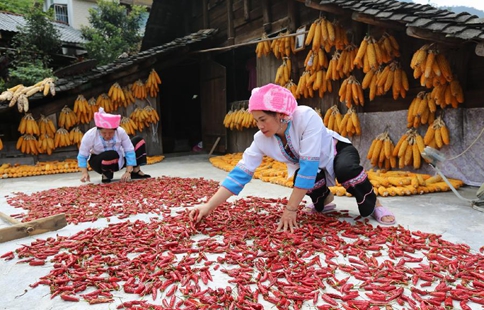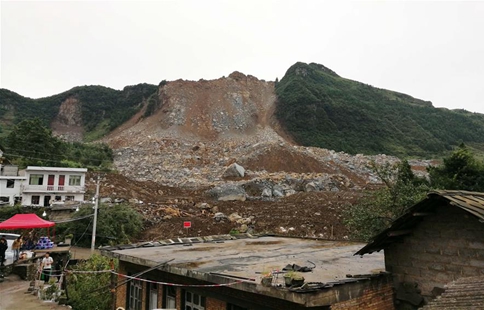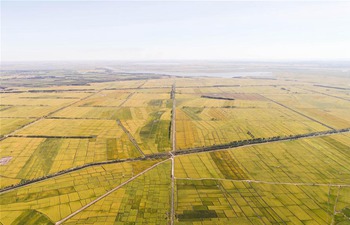By Matthew Rusling
AURORA, WEST VIRGINIA, Sept. 3 (Xinhua) -- The first time Jordan ever did heroin, he thought it was the most amazing feeling in the world.
"I'm not going to lie - it's better than sex. The feeling. I don't think a feeling like that should be allowed in this world," he tells Xinhua reporter.
But soon the drug began to take hold of him, like an evil puppet master that controlled everything he did, thought and felt. He began to lie, manipulate and steal just to get his hands on the drug.
After a while, getting his heroin fix became an obsession and led to homelessness, as it was impossible to manage his addiction and continue to go to work every day.
Heroin became more important than even eating and drinking, he says.
"I put that in front of food, sex, water," he told reporter.
"I lost my job and I had nowhere to live. I was living under some trees," says Jordan, now in his mid-20s.
Experts call America's current drug epidemic the most deadly drug the nation has ever seen, at least in modern times.
An estimated 1 million Americans are active heroin users, and the U.N. Office of Drugs and Crime finds that heroin use is at its highest level in the last 20 years. The number of uses has doubled since the year 2000, according to government figures.
2015 saw the most deaths due to drug overdoses in the nation' s history, according to a report published in December from the Centers for Disease Control and Prevention, a U.S. government department.
Over 50,000 Americans died from drug overdoses in 2015, according to that report, which contains the most recent available statistics. The number surpassed, for the first time ever, the number of gun deaths in the United States. The surge has been driven by the use of heroin as well as by the abuse of a class of powerful prescription drugs called opioids, which are similar to heroin.
There are many drug rehabilitation facilities nationwide, but many are unsuccessful, and addicts remain hooked.
But Jordan, age 27, is one of eight current residents in a new program that is trying a different approach to treating the problem.
The facility, called Jacobs Ladder, is located in rural West Virginia - ground zero of America's drug epidemic. Xinhua reporter was given access to the place and was permitted to walk around freely and interview whoever wanted to talk.
The program has only been in existence for a year but staff and residents say it has had positive results. Out of 15 graduates, there has only been one has relapse.
That sits in stark contrast to many typical rehab programs.
Some residents here have been in several rehab programs in the past, without much success.
Much of that is because most drug treatment programs consist of only one month in which patients fill their days with meetings to discuss their problems, from morning to night, for around 30 days. But they don't learn a new way of thinking. The time allotted is not long enough to find a solution, and patients are often sent back to the same neighborhoods and same group of friends that got them hooked in the first place.
Jacobs Ladder, however, says it provides residents with a way to move on from their addiction, by teaching them to lead active, healthy lifestyles so they can move on from their drug habits. The goal is to teach them a new way of living and thinking, according to staff and residents with whom this reporter spoke.
The program also keeps graduates connected with a support network after they leave, so they can avoid relapsing.
The center is located in rural West Virginia, surrounded by trees and rolling green hills.
Instead of sitting around talking all day and focusing on their addiction, residents do farm work - learning how to raise sheep and cattle, and get eggs from chickens. They eat much of the food they produce, as the program teaches them to treat their bodies well, and that means a high-protein, high vegetable, low carb, low sugar, natural diet.
The place also has regular yoga classes and meditation, which teaches residents to focus. Residents get a lot of fresh air and sunshine, and lift weights in a gym at the facility. There are music therapy classes, in which a musician helps them write a song about their addiction, and residents later make a music video and post it on YouTube.
Corey, age 27, is another resident.
Half way up the side of a rolling green hill, Corey sits on the hood of a truck and talks about why he's here.
He's just finished feeding a flock of chickens. With the chickens squawking nearby, he says he got hooked on drugs in a desperate attempt to get close to his mother, a drug user.
"I thought maybe if I started using (drugs) I could grow our bond back together," he says, explaining that he had been taken away from her when he was a child.
"I started getting high when I was 17 years old and we weren't mom and son, we were 'get high buddies,' " he says. "But in the end that tore us apart even more. There was a point in life when I got completely strung out and in a sense turned against her," he says.
He says he'll be in the program for six months, adding that he believes the program has saved his life, although he has not completed the full six months yet.
He says he's going to move somewhere else after he gets out, as he doesn't want to return to the same environment, as his home town is infested with drugs.
"It's everywhere. It's bad," he says.
"Actually I started recovery in 2013, but they were not all success stories," he says.
"The people here are great the staff are amazing. It' s not like they're indifferent from us. It's like they' re a part of us," he says.
"Just in the last eight months, I've been to six different detox facilities. But I kept returning back to the same place, same family, same friends, same area," he says, reflecting the sentiment of many drug users that returning to the same drug-infested environment after treatment will get you hooked all over again.
"And this right here....you build a new family, and you network together, and you become a team," he says, explaining that many other facilities just want to get patients in and out.
"Here it's like having a family base. You become more goal oriented," he says.
Indeed, one of the reasons the program includes farm work is because it teaches a sense of planning for the future. Planting vegetables, for example, teaches participants not to crave instant satisfaction - such as the kind that drugs give - and to do things today that will result in a positive result tomorrow, such as planting vegetables, watching them grow and eating them fresh later.
Corey says doing farming has also enabled him to take his mind off his addiction.
"You want to make sure the cattle have food, you want to make sure the chickens are ok," he says.
"You get to a point in life where you don't want to live that kind of life anymore," Corey says. "Addiction took everything away from me that I loved. It kind of made me go numb. I lost everything that was worth any value - family, friends," he says.
A COMPLEX SET OF FACTORS
The reasons for the nationwide drug addiction are complex, but they boil down to two main factors, says the facility's founder, Kevin Blankenship, a medical doctor who grew up in West Virginia.
He believes those are the Internet and the powerful prescription opiates flooding local markets.
A whole generation of youth, he says, has grown up socially isolated because of the Internet. Young people today, rather than go outdoors and have human interaction, stay inside and chat on social media constantly. For some, it leads to a feeling of isolation.
"Isolation is a big part of addiction. And the only community they (drug users) end up knowing is fellow (drug) users and the dealers. So that's really their only social structure. Outside of that they're pretty much on their own," he says, standing on the porch of the main house where residents stay.
"There's something to be said for social interaction online, but when that's your only source of social interaction, it's detrimental," he says.
"We've got a generation of kids right now who don't feel connected," he says.
At the same time, around a decade ago, the U.S. medical establishment made a concerted effort to train doctors to make the treatment of pain a priority, such as pain from a serious car accident or terminal cancer, as well less serious issues.
The U.S. pharmaceutical industry made available a plethora of powerful opioids available by prescription. They often work wonders in terms of alleviating pain, but they are highly addictive, and are often abused.
Over the years, U.S. drug regulators increased the level of allowed dosages, making opioids stronger and more addictive.
When patients recovered from their illnesses, they developed an addiction. But cut off from the opioids, they turned to a much cheaper alternative - heroin.
It was in this way that the nation's addiction was born.
"The availability of such a potent drug (opioids) helped fan the flames, but without that, we've still got a problem. We've still got a generation of kids who feel like anomalies and don't feel connected and don't feel part of a social structure," he says.
The mostly rural state of West Virginia used to be known for rolling hills, coal mines, family values and clean living. Communities are tight-knit in this state, where one sees very few cars on the road and not much traffic. Parts of the rural areas are truly serene, with lush green forests and cool summer temperatures.
An iconic American country music song from decades ago, entitled "Take me home, country roads," by music legend John Denver, referred to the state as "Almost heaven," when he sang of the beauty of the "Blue Ridge Mountains, Shenandoah river."
But now, Ohio, Kentucky and West Virginia are three of the worst afflicted states for U.S. drug addiction, as they are coal mining and manufacturing states where many factories have packed up and left. That has followed an ongoing nationwide trend away from manufacturing, which has left millions of Americans unemployed and underemployed, and with bleak financial prospects.
"Part of that is because these are mining and industrial states. So when the jobs left, people started working the system however they could to support their families. And one big industry in these states is disability," Blankenship says, referring to the government system of being reimbursed for disabilities or injuries that leave people unable to work.
But in order to collect government disability payments, people must prove they are in pain and can't work. To prove that, people get prescriptions for powerful opioid painkillers. But the medication is highly addictive, and many have become enslaved to opioids this way.
"So if you can go through the steps to prove that you have a work related injury and you have a disability and you can't work, then you get government funding to support yourself and your family. It's a real thing, and part of that game that you have to play, is you've got to establish with a doctor, you've got to prove your injury and your pain...and the only way to prove that is to exaggerate the (pain) symptoms to the point that the doctors will then prescribe strong, addictive narcotics to treat your pain, and that... gets that person addicted. They over-prescribe in a lot of instances," Blankenship says.
In order to make ends meet in a harsh rural economy, many people end up selling the drugs they were prescribed.
"So now they've got these pills in their cupboard that they'll sell. So now you've got more people getting addicted," he says.
'I STARTED DRUGS IN HIGH SCHOOL'
While years ago many people - even those using drugs - would never dream of sticking a needle in their arm to get high, the use of heroin has become almost normal in many circles of young people in the United States these days.
"I got started in high school," Jordan says, explaining that he was popping pills to get high, and the decision to use heroin wasn't an overnight decision. But he found that heroin was cheaper than the prescription pain killers he was taking, so he turned to heroin.
"It was pretty common, a bunch of people would pop pills in high school, and a lot of people I went to high school with, I know are still out there doing it, because I was doing it with them," he says.
When Xinhua reporter asked if people develop a tolerance to heroin and need to constantly increase the dosage to feel its euphoric effects, he says "absolutely."
Jordan says heroin quickly became "almost a 150- dollar habit a day." When asked how he got the money to feed his addiction, he says, "there's ways. There's some illegal things...You know, just dirty tricks of the game. You might know someone you don't like too much and you end up ripping them off. Or I'll go convince my dad, manipulate him to give me some money, so it was just anything I could do (to get money for heroin)."
"It compromises your morals," he says. "It overrides everything," he says.
While Hollywood often portrays users of hard drugs as residents living in tough, inner-city neighborhoods - and often minorities - the U.S. drug problem has moved into middle class communities far from urban centers.
"It's moved out of lower-income populations...like inner cities...and it goes to the suburbs, because there' s money there," he says.
Jordan had been in different treatment centers for drugs before he tried heroin. And ironically, the first time he tried heroin was in a rehab center he had previously been in.
"It was a pretty relaxed place. You were allowed to leave the premises, like go to the bookstore or something," he says of a previous treatment center.
"Everyone there, they would glorify everything, saying things like 'oh, you never tried a needle? Oh, man you gotta try it, it's the greatest fucking feeling ever,'" other patients told him while he stayed in a treatment center in the past.
"I tried it the first time there and, going home, I was like 'where can I get this,' " he says. "But I was younger then, and you really couldn't tell me anything," he says.
It was always easy for him to get drugs growing up in West Virginia, he says.
"It's pretty prevalent now," he says of the area where he's from in West Virginia, adding that the drugs come from dealers in many different places, from Detroit to Pittsburgh to Ohio to New York to Philadelphia.
The U.S. Drug Enforcement Administration says the main heroin supplier to the U.S. is Mexico, although heroin can also come from South America, Southeast Asia and Southwest Asia.
"The big cities (drug dealers) come down to Morgantown (West Virginia) because it's a college town, and they can charge outrageous prices because these kids, some of them are spoiled kids... have a lot of money," and their parents give them money anytime they ask, he says.
Jordan added that there are periodic crackdowns by the authorities, which he refers to as "spring cleaning," as they tend to occur every spring, but the crackdowns don't really curb the problem, he says.
"They gotta find a different way to tackle the problem," he says, adding that treatment is a better solution than punishment.
Speaking of the Jacob's Ladder facility, he says it' s the most unique treatment center he's been to, "and I' ve got a good bit of treatment centers under my belt," he says.
Of treatment centers he's been in previously, he said he just met in groups all day to talk about his addiction with others, but it never helped him. One of the reasons is that he was just talking about his addiction all day.
That sits in sharp contrast to his current situation, where he is doing farm work and several other activities as a part of his recovery, to get his mind on other things besides his addiction.
Instead of endless sessions of psychoanalysis, which is the mainstay of many other programs, here "we define the problem and see what we can do to move on from it," he says.
"And you get six months here. Some other places you' re in there for four weeks," he says.
"(Here) it's a pretty unique set-up, with the farm work. We get our eggs, the beefalo, the pigs, the sheep, the lamb we ate was delicious."
"As far as finding a solution, at a lot of other places you don't have enough time to find a solution," he says.
"At other places you' re just a head so they can charge the insurance companies," he says.
He says he doesn't regret the past, "what happened, happened," he says, adding that he can use his own experience to help others.
"I can use my past (to help people). I have an arsenal of things I've been through." If someone is dealing with problems, "I can say hey, I've been through that too."
He says the drug situation in high schools in the area may be getting worse that when he was in high school several years ago, having graduated in 2008.
INSURANCE COMPANIES AND AMERICA'S DRUG REHAB INDUSTRY
Blankenship wants to expand the program, and they are just finishing up another building where they can double capacity. So he hopes to have 25 or 30 beds available soon.
He said he doesn't want to take payments from insurance companies, which is why the facility is private pay-based. The reason is that once insurance companies become involved, they can in many instances dictate the way patients are cared for, as they are the ones ultimately writing the check.
"Part of the problem with the rehabilitation industry now is that it's driven by what will an insurance company pay for. And right now they'll pay for a 30-day in most instances," he says. "And not only that, but they also dictate the contact hours with a psychologist or a trained counselor for (a certain amount of) hours a day, so what that ends up perpetuating is that you go from meeting to meeting to meeting to meeting, and then go to bed, and then you get up the next day and do the same thing," he says.
Many in those programs get out after 30 days and end up in the same cycle of using drugs and run-ins with law enforcement.
"We had a guy who graduated just a few months ago, and he'd been through ten rehabs. And he came to our program and he's working down on Morgantown (West Virginia) and he's doing wonderful right now," he says.
While showing Xinhua reporter around the farm, with the squawking of chickens in the background, Blankenship says it's tremendously therapeutic for residents to interact with the animals, in terms of caring for and feeding them.
"It's not only interacting with and touching the animals, but the land. Get your hands in the dirt. Grow something and connect with something bigger than you," he says.
"Because so much of addiction is about isolation centering inside your own head and inside your own world," he says.
"If we can get them out of that and get them connected to something bigger than they are, it makes it so much easier for them then to step back and look at how they've been living, and what they've been living without," Blankenship says.

















